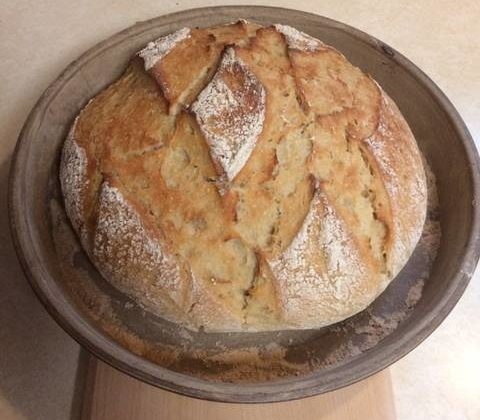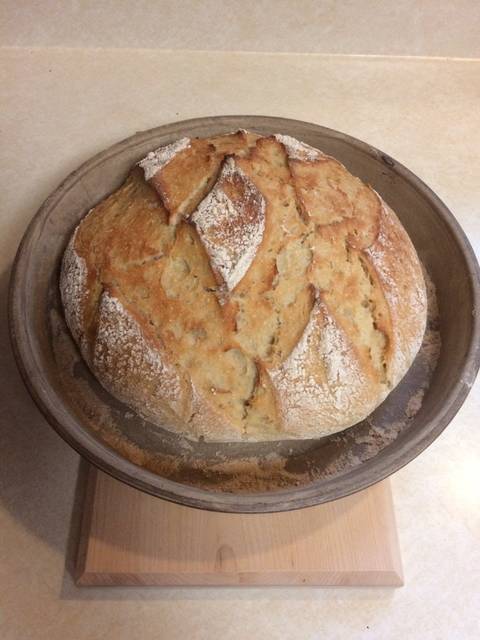
From L. Mark Kibler
Morning Meadow Farm, Blanchester

Wild Sourdough Starter
Making your own sourdough starter culture is simple because there is wild yeast in the air all around us. All you have to do is catch some and help it to start growing.
You will need:
• 2-4 small glass containers or small bowls, large enough to hold 1/3 cup of water
Choose containers with wide mouths/openings.
• Pure water
This can be distilled water, fresh spring water, etc. Try to avoid water that has been chemically treated or chlorinated.
• 1 teaspoon of natural sugar per container
This can be honey, pear juice, apple juice, pineapple juice, agave nectar, etc. I’ve tried all of these and the different types of sugar tend to “catch” different strains of wild yeast, each with its own unique taste. Some are have a mild sourdough taste and some are quite tangy. Wild yeast is more resistant to acid than baker’s yeast and so the acid in the fruit juice is not a concern.
• Untreated, unbleached flour of your choice — 2-4 tablespoons per container
• A glass stirring rod or a clean fork or spoon
This is to stir the starter culture. As you catch and grow different strains of wild yeast, use a different clean stirrer when you feed (add sugar) to the growing cultures. If you use the same spoon in the different cultures you will cross-contaminate them and end up with two (or three) different yeasts in the same container/culture.
• A small piece of window screen or similar material — one for each container
This is to keep insects out. The screen should have holes large enough to allow the wild yeast to fall into the water-sugar solution.
Here’s how:
Put 1/3 cup of warm or somewhat hot water into each container.
Stir one teaspoon of the sugar(s) you plan to use into the water.
Add the flour until the consistency of the water/sugar is “soupy” or slightly watery.
Place the container(s) somewhere that has a slight breeze and that is warm (around 75-85 degrees) but not blistering hot (such as full summer sunlight). Outside on a small table or inside near an open window is a good spot and wild yeast will blow in on the wind. Too much heat and wind though, and the water/flour mixture will dry out.
Cover each container with a small piece of screen to keep insects out.
Let the containers sit for 2-5 days to catch wild yeast. Gently stir the containers once a day to mix the yeast into the flour/water/sugar solution.
Be patient. Good things take time and not all of the containers will catch wild yeast. In the containers that do catch wild yeast you will see small bubbles start to form in the mixture. This is from the gas that is being released as the yeast grows or reproduces. When you see bubbles beginning to form on top of the solution, add enough warm water, sugar and flour to increase the size of the mixture by about 50% or so. You have begun to feed your growing yeast cultures.
Not all the containers will catch wild yeast and you may have to repeat the whole process two or three times before it works. That’s why using multiple containers the first time you do this is recommended.
You will not see gas bubbles in the liquid in the containers that didn’t catch wild yeast. After 3-5 days you may see a brown watery liquid on top of these mixtures and they may have a mildly foul smell. Discard them, clean the containers well, and start again if you’d like.
NOTE: After a healthy, growing culture sits for several days you will also see brown liquid form on top of the “dough.” This is a byproduct of yeast reproduction. It’s also a sign that it’s time to use or discard the top half of this particular culture and feed it some more sugar-flour-water.
Once you have wild sourdough yeast cultures growing, transfer all the levain (a fancy word for the starter culture) into a wide mouth quart jar or similar glass container with a (loose) lid. Keep the container somewhere warm and keep feeding it with sugar-flour-water until the jar is about half full of levain/starter. At this point you can use half of the mixture, keeping the other half in the jar to feed and use … again and again and again.
To make sourdough, add the amount of flour, water and sugar that you would to any bread dough, then knead it according to your recipe. Please note that sourdough often requires more than twice, even three times the normal amount of time to fully rise, so factor this into your recipe.
ID, 'source', true); $sourcelink = get_post_meta($post->ID, 'sourcelink', true); $sourcestring = '' . __('SOURCE','gabfire') . ''; if ($sourcelink != '') { echo "
$sourcestring: $source
"; } elseif ($source != '') { echo "$sourcestring: $source
"; } // Display pagination $args = array( 'before' => '' . __('Pages:','gabfire'), 'after' => '
', 'link_before' => '', 'link_after' => '', 'next_or_number' => 'number', 'nextpagelink' => __('Next page', 'gabfire'), 'previouspagelink' => __('Previous page', 'gabfire'), 'pagelink' => '%', 'echo' => 1 ); wp_link_pages($args); // Display edit post link to site admin edit_post_link(__('Edit','gabfire'),'','
'); // Post Widget gab_dynamic_sidebar('PostWidget'); ?>